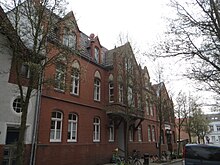Lutherhof (Greifswald)
The Lutherhof is a listed building complex in Greifswald's Martin-Luther-Straße 8.
History and use
The Lutherhof was built as a community center with apartments, community rooms and a hall. The design came from the Berlin architect August Orth ; it was one of Orth's last drafts. Its brick architecture is somewhere between the late neo-Gothic and the incipient homeland security architecture . He created a nine-axis, two-story building with a neo-Gothic facade and a mansard roof . On the right side there is a three-axis, gable-independent hall building with the Luther Hall . The gallery of the large hall was later converted into a separate small hall. The facade is characterized by alternating plaster fields and brick sections. In the living area, a bay window with iron console supports divides the facade. Above the hall entrance, an inscription Luther-Hof and terracotta statues by Martin Luther and Philipp Melanchthon of the Ernst March Söhne pottery factory in Berlin-Charlottenburg indicate the purpose of the building. Strong wrought iron door fittings evoke medieval craftsmanship. A serene, almost painterly effect comes from the rich and differentiated façade design .
On June 3, 1901, the inauguration took place by the Pomeranian general superintendent Heinrich Poetter . With the Lutherhof, a large hall was now available for lectures and meetings. During the church struggle, meetings of the Confessing Church took place in the often overcrowded hall with lectures by Rudolf Hermann , Karl von Scheven and Martin Niemöller . In 1934 it was the scene of a Schleiermacher celebration by the church and university. In 1935 Dietrich Bonhoeffer spoke in the Lutherhof.
In 1945 it served as a refuge for the institutions of the Pomeranian Church Province that had fled from Stettin , from which the Pomeranian Evangelical Church emerged until the Evangelical Consistory Greifswald found its own rooms in Bahnhofstrasse. The 20th Pomeranian Provincial Synod met here on October 9, 1946 , the first after the war, and the Synod of the Pomeranian Evangelical Church met here until the church hall in Züssow was completed in 1957. In 1989 the New Forum Greifswald was founded here.
From 2015, the Lutherhof was extensively renovated , among other things because of infestation with dry rot. The re-inauguration took place on January 6, 2018.
In addition to the apartments, the current users of the Lutherhof are the Protestant student community at the University of Greifswald , choirs, learning courses and, in the courtyard building, the Kinderladen daycare center run by a parents' initiative . The Lutherhof is a rehearsal and event location for the Greifswald Bach Week .
organ
In 1976 the hall in the Lutherhof received an organ from the organ builder Rudolf Böhm from Gotha . It was completely overhauled in 1999 by Lothar Banzhaf (Husum). The organ is fully mechanical with mechanical tracker action , mechanical slider chests and mechanical stop action. It comprises twelve registers on two manuals and a pedal .
|
|
|
|||||||||||||||||||||||||||||||||||||||||||||
Coupling: II / I, I / P, II / P (as steps) Tremulant (as step) Sill (as balance step)
- Remarks
literature
- Greifswald: Martin-Luther-Straße; August Bebel School, residential buildings, commercial vocational school, Lutherhof. In: Gerd-Rainer Baier (arr.) The architectural and art monuments in Mecklenburg-Western Pomerania. Western Pomerania coastal region with Stralsund, Greifswald, Rügen and Usedom. Henschelverlag, Berlin 1995, p. 428 f.
Web links
Individual evidence
- ↑ Bernfried Lichtnau: Architecture in Greifswald from 1900 to the present. In: Horst Wernicke (Ed.): Greifswald. History of the city. Helms, Schwerin 2000, ISBN 3-931185-56-7 , p. 477.
- ^ Friedrich Winter: Bishop Karl von Scheven (1882-1954). In: Baltic Studies , Pomeranian Yearbooks for Regional History , Volume 92 (New Series), Ludwig, Kiel 2006, ISBN 3-937719-51-2 , ISSN 0067-3099 , p. 139.
- ^ Greifswald Lutherhof renovation is complete , report from the North Church of January 2, 2018, accessed on 6. January 2018
- ↑ Lecture at the regional synod of the Pomeranian Evangelical Church (PEK) on October 13, 2006 in Züssow by Prof. Dr. Martin Onnasch , Greifswald, Official Gazette of the Pomeranian Evangelical Church 2006, No. 2, p. 3
- ↑ Joachim Wächter, Norbert Buske: Festschrift for the 700th anniversary of the Greifswald churches. Living preaching of the fathers. (Ed. on behalf of the Evangelical Church of Greifswald and the Church District of Greifswald-Stadt) Evangelische Verlags-Anstalt, Berlin 1980, p. 67.
- ^ Greifswald Lutherhof renovation is complete , report from the North Church of January 2, 2018, accessed on 6. January 2018
- ^ According to Markus T. Funck: The organs of the Hanseatic city of Greifswald. A contribution to the history of Pomeranian organ building. (= Contributions to the history of architecture and the preservation of monuments in Mecklenburg and Western Pomerania , Volume 8.) (Dissertation, University of Greifswald, 2005.) Helms, Schwerin 2009, ISBN 978-3-935749-93-0 , p. 222. (there also the following Disposition)
Coordinates: 54 ° 5 ′ 35.6 ″ N , 13 ° 22 ′ 41.6 ″ E


